How to Add and Subtract Fractions With Different Denominators
Add and Subtract Fractions with Different or Unlike Denominators
To add or subtract fractions with different denominators, we need to do some extra steps. The general approach is discussed below. We will go over a few examples in this lesson to make sure you get comfortable with the procedure.
Steps How to Add or Subtract Fractions with Different Denominators
Step 1: Given two unlike fractions where the denominators are NOT the same.

Step 2: Make the denominators the same by finding the Least Common Multiple (LCM) of their denominators. This step is exactly the same as finding the Least Common Denominator (LCD).

Step 3: Rewrite each fraction into its equivalent fraction with a denominator which is equal to the Least Common Multiple that you found in step #2. .


Step 4: Now, add or subtract the "new" fractions from step #3. Always reduce the answer to its lowest terms.
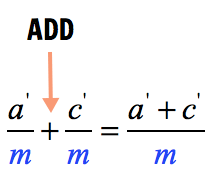
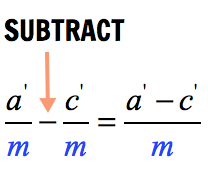
Examples of Adding and Subtracting Fractions with Unlike Denominators
Example 1: Add the fractions with different denominators .

The two fractions have denominators that are not equal. We need to make them equal by finding their Least Common Multiple that will serve as their Least Common Denominator (LCD).
Start by listing the multiples of each denominator, and identify the least number that is common to both of them.

The first fraction already has a denominator equal to the LCM = 15, and so we will leave it alone.
The second fraction requires some adjusting to make its denominator equal to 15. Do that by multiplying its numerator and denominator by the number 3.
- Once their denominators are equal, add the fractions by adding their numerators and then copying the common denominator.
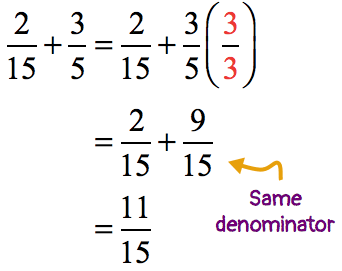
The fraction {{11} \over {15}} is our final answer because it is already in its lowest term.
Example 2: Add the fractions with different denominators .

We can't add the two fractions just yet because they have different denominators, namely 5 and 9. Begin by listing their multiples and pick the smallest number that is common to both. This will become their common denominator.

Now, convert each fraction to an equivalent fraction with the LCM as its denominator, then proceed with regular addition.
Look for the opportunity to reduce the answer to its lowest term. The numerator and denominator of {{33} \over {45}} is divisible by 3.
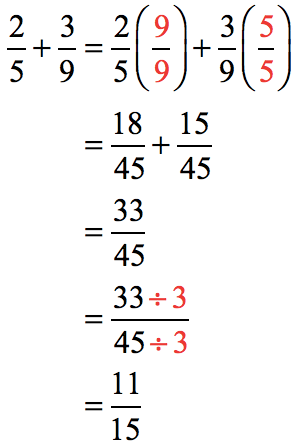
Example 3: Add the fractions with different denominators .

Sometimes there is no need to find the least common denominator by list method. We can immediately find it whenever the two numbers are both primes.
- A prime number is a number divisible only by 1 and itself.
Observe that the denominators 3 and 5 are primes. The LCD will simply be their product, that is, 3 x 5 = 15.
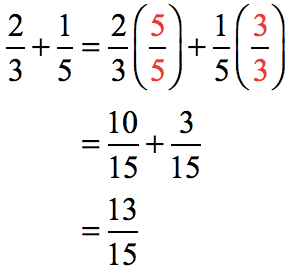
Example 4: Add the fractions with different denominators .

Solution:
Find the least common multiple of the denominators.

Make the necessary adjustments in the denominator and proceed as usual. Reduce your final answer to the lowest term.
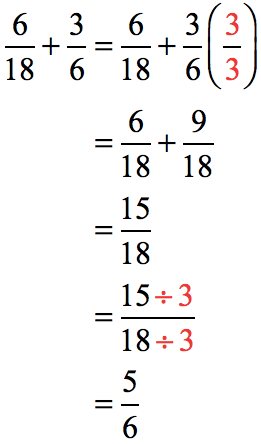
Example 5: Add the fractions with different denominators .

Solution:
Since the denominators 11 and 13 are both prime numbers, the least common denominator will be their product.

Convert the current denominators of the two fractions into the LCD, and proceed with regular addition.
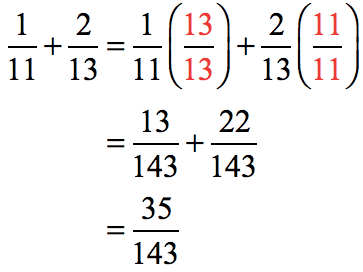
Example 6: Subtract the fractions with different denominators .

To subtract these fractions with unequal denominators is very similar to addition.
Make their denominators equal using the concept of least common multiple. Then subtract their numerators accordingly.

Rewrite each fraction to its equivalent fraction with a denominator equal to the LCM = 30, then subtract their numerators. Make sure to reduce your answer to the lowest term.
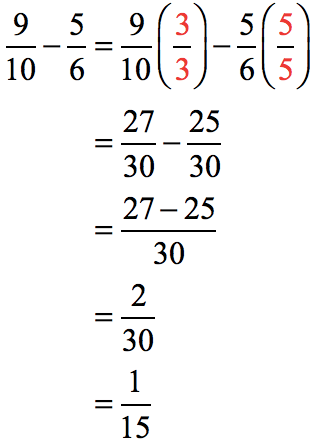
Example 7: Subtract the fractions with different denominators .

Since the denominators are both prime numbers, their LCM is just their product, thus 7 x 5 = 35.
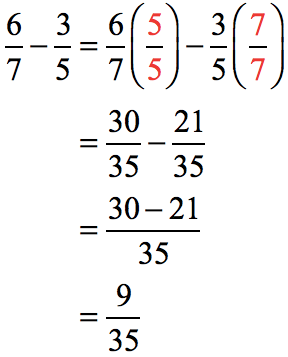
Example 8: Subtract the fractions with different denominators .

Solution:
Find the least common denominator by determining the LCM of the denominators.

Rewrite the two fractions with a common denominator equal to the LCM = 42. Subtract their numerators, and reduce the answer to the lowest term if possible.
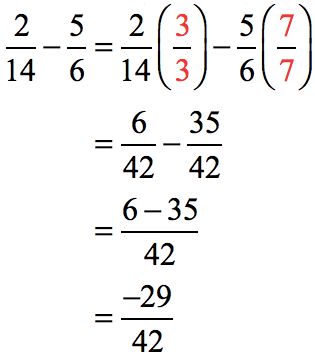
Example 9: Subtract the fractions with different denominators .

Solution:
Find the least common denominator by solving for the least common multiple of the denominators.

We make adjustments to the existing fractions to make their denominator equal to the LCD = 40. After doing so, subtract their numerators and copy the common denominator.
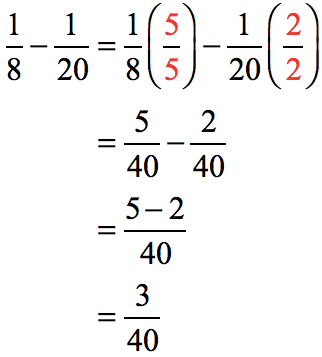
Practice with Worksheets
You might also be interested in:
Adding and Subtracting Fractions with the Same Denominator
Multiplying Fractions
Dividing Fractions
Simplifying Fractions
Equivalent Fractions
Reciprocal of a Fraction
How to Add and Subtract Fractions With Different Denominators
Source: https://www.chilimath.com/lessons/introductory-algebra/adding-and-subtracting-fractions-with-different-denominators/
0 Response to "How to Add and Subtract Fractions With Different Denominators"
Post a Comment